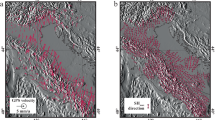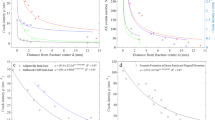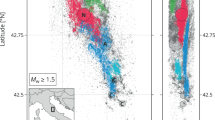Abstract
The earthquake size distribution follows, in most instances, a power law1,2, with the slope of this power law, the ‘b value’, commonly used to describe the relative occurrence of large and small events (a high b value indicates a larger proportion of small earthquakes, and vice versa). Statistically significant variations of b values have been measured in laboratory experiments, mines and various tectonic regimes such as subducting slabs, near magma chambers, along fault zones and in aftershock zones3. However, it has remained uncertain whether these differences are due to differing stress regimes, as it was questionable that samples in small volumes (such as in laboratory specimens, mines and the shallow Earth's crust) are representative of earthquakes in general. Given the lack of physical understanding of these differences, the observation that b values approach the constant 1 if large volumes are sampled4 was interpreted to indicate that b = 1 is a universal constant for earthquakes in general5. Here we show that the b value varies systematically for different styles of faulting. We find that normal faulting events have the highest b values, thrust events the lowest and strike-slip events intermediate values. Given that thrust faults tend to be under higher stress than normal faults we infer that the b value acts as a stress meter that depends inversely on differential stress.
This is a preview of subscription content, access via your institution
Access options
Subscribe to this journal
Receive 51 print issues and online access
$199.00 per year
only $3.90 per issue
Buy this article
- Purchase on Springer Link
- Instant access to full article PDF
Prices may be subject to local taxes which are calculated during checkout


Similar content being viewed by others
References
Ishimoto, M. & Iida, K. Observations of earthquakes registered with the microseismograph constructed recently. Bull. Earthquake Res. Inst. Tokyo Univ. 17, 443–478 (1939)
Gutenberg, B. & Richter, C. F. Frequency of earthquakes in California. Bull. Seismol. Soc. Am. 34, 185–188 (1944)
Wiemer, S. & Wyss, M. Mapping spatial variability of the frequency–magnitude distribution of earthquakes. Adv. Geophys. 45, 259–302 (2002)
Frohlich, C. & Davis, S. D. Teleseismic b values; or, much ado about 1.0. J. Geophys. Res. 98, 631–644 (1993)
Kagan, Y. Y. Universality of the seismic moment–frequency relation. Pure Appl. Geophys. 155, 537–574 (1999)
Bender, B. Maximum likelihood estimation of b values for magnitude grouped data. Bull. Seismol. Soc. Am. 73, 831–851 (1983)
Shi, Y. & Bolt, B. A. The standard error of the magnitude–frequency b-value. Bull. Seismol. Soc. Am. 72, 1677–1687 (1982)
Utsu, T. Report of the Joint Research Institute for Statistical Mathematics Vol. 34, 139–157 (Institute for Statistical Mathematics, Tokyo, 1992)
Hauksson, E. Crustal structure and seismicity distribution adjacent to the Pacific and North America plate boundary in southern California. J. Geophys. Res. 105, 13875–13903 (2000)
Mogi, K. Magnitude–frequency relations for elastic shocks accompanying fractures of various materials and some related problems in earthquakes. Bull. Earthquake Res. Inst. Univ. Tokyo 40, 831–853 (1962)
Scholz, C. H. The frequency–magnitude relation of microfracturing in rock and its relation to earthquakes. Bull. Seismol. Soc. Am. 58, 399–415 (1968)
Wyss, M. Towards a physical understanding of the earthquake frequency distribution. Geophys. J. R. Astron. Soc. 31, 341–359 (1973)
Mori, J. & Abercrombie, R. E. Depth dependence of earthquake frequency–magnitude distributions in California: Implications for rupture initiation. J. Geophys. Res. 102, 15081–15090 (1997)
Gerstenberger, M., Wiemer, S. & Giardini, D. A systematic test of the hypothesis that the b value varies with depth in California. Geophys. Res. Lett. 28, 57–60 (2001)
Wyss, M. & Matsumura, S. Most likely locations of large earthquakes in the Kanto and Tokai areas, Japan, based on the local recurrence times. Physics of the Earth and Planetary Interiors 131, 173–184 (2002)
Kagan, Y. Y. Seismic moment distribution revisited: I. Statistical results. Geophys. J. Int. 148, 520–541 (2002)
Amitrano, D. Brittle–ductile transition and associated seismicity: Experimental and numerical studies and relationship with the b value. J. Geophys. Res., B2044 (2003) (doi:10.1029/2001JB000680)
Urbancic, T. I., Trifu, C. I., Long, J. M. & Young, R. P. Space-time correlations of b-values with stress release. Pure Appl. Geophys. 139, 449–462 (1992)
Wiemer, S., McNutt, S. R. & Wyss, M. Temporal and three-dimensional spatial analysis of the frequency-magnitude distribution near Long Valley caldera. California. Geophys. J. Int. 134, 409–421 (1998)
Hauksson, E. Earthquakes, faulting, and stress in the Los Angeles basin. J. Geophys. Res. 95, 15365–15394 (1990)
Amelung, F. & King, G. The difference between earthquake scaling laws for creeping and non-creeping faults. Geophys. Res. Lett. 24, 507–510 (1997)
Wiemer, S. & Wyss, M. Mapping the frequency–magnitude distribution in asperities: An improved technique to calculate recurrence times? J. Geophys. Res. 102, 15115–15128 (1997)
Schorlemmer, D., Wiemer, S. & Wyss, M. Earthquake statistics at Parkfield: 1. Stationarity of b-values. J. Geophys. Res. 109, B12307 (2004) (doi:10.1029/2004JB003234)
Schorlemmer, D. & Wiemer, S. Microseismicity data forecast rupture area. Nature 434, 1086 (2005)
Huang, J. & Turcotte, D. L. Fractal distributions of stress and strength and variations of b-value. Earth Planet. Sci. Lett. 91, 223–230 (1988)
Smith, W. D. The b-values as an earthquake precursor. Nature 289, 136–139 (1981)
Lei, X. et al. Detailed analysis of acoustic emission activity during catastrophic fracture of faults in rock. J. Struct. Geol. 26, 247–258 (2004)
Oglesby, D. D., Archuleta, R. J. & Nielsen, S. B. Dynamics of dip-slip faulting: Explorations in two dimensions. J. Geophys. Res. 105, 13643–13653 (2000)
Acknowledgements
We thank E. Hauksson, D. Giardini, M. Mai, M. Gerstenberger, D. Jackson, J. Woessner and G. Hillers for discussions. We thank the Northern California Seismic Network, US Geological Survey, Menlo Park, and the Berkeley Seismological Laboratory, University of California, Berkeley, for the catalogue including phase data, and the National Research Institute for Earth Science and Disaster Prevention for mechanism solutions of the Kanto-Tokai area.
Author information
Authors and Affiliations
Corresponding author
Ethics declarations
Competing interests
Reprints and permissions information is available at npg.nature.com/reprintsandpermissions. The authors declare no competing financial interests.
Rights and permissions
About this article
Cite this article
Schorlemmer, D., Wiemer, S. & Wyss, M. Variations in earthquake-size distribution across different stress regimes. Nature 437, 539–542 (2005). https://doi.org/10.1038/nature04094
Received:
Accepted:
Issue Date:
DOI: https://doi.org/10.1038/nature04094
This article is cited by
-
b map evaluation and on-fault stress state for the Antakya 2023 earthquakes
Scientific Reports (2024)
-
Stress-driven recurrence and precursory moment-rate surge in caldera collapse earthquakes
Nature Geoscience (2024)
-
Analysis of Near-Field Stresses in an Analogue Strike-Slip Fault Model
Rock Mechanics and Rock Engineering (2024)
-
Seismic b value analysis of north Pakistan: an appraisal
Environmental Earth Sciences (2024)
-
Statistical analysis of seismic b-value using non-parametric Kolmogorov–Smirnov test and probabilistic seismic hazard parametrization for Nepal and its surrounding regions
Natural Hazards (2024)
Comments
By submitting a comment you agree to abide by our Terms and Community Guidelines. If you find something abusive or that does not comply with our terms or guidelines please flag it as inappropriate.



